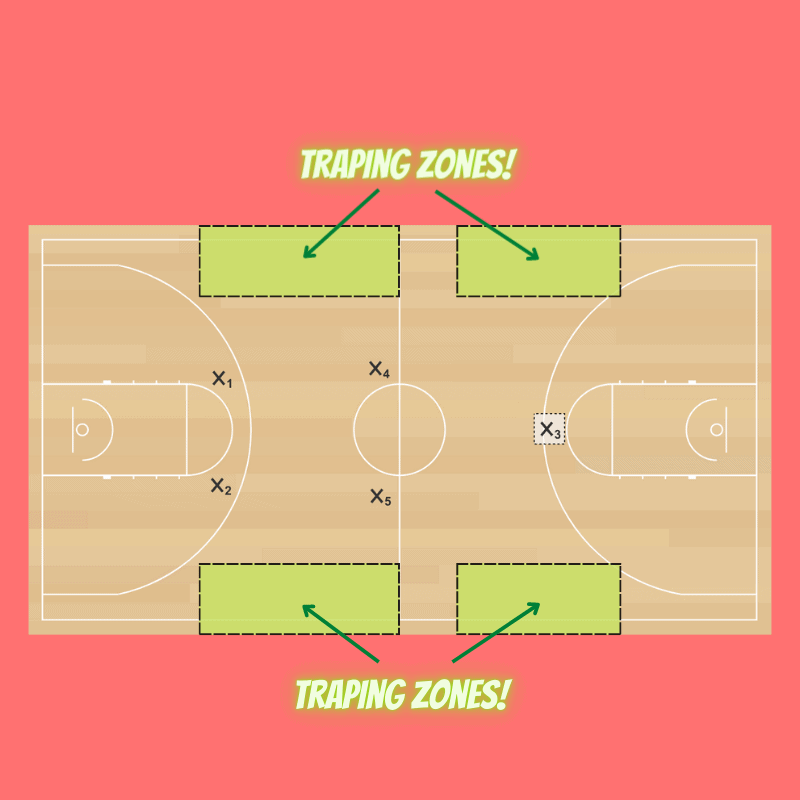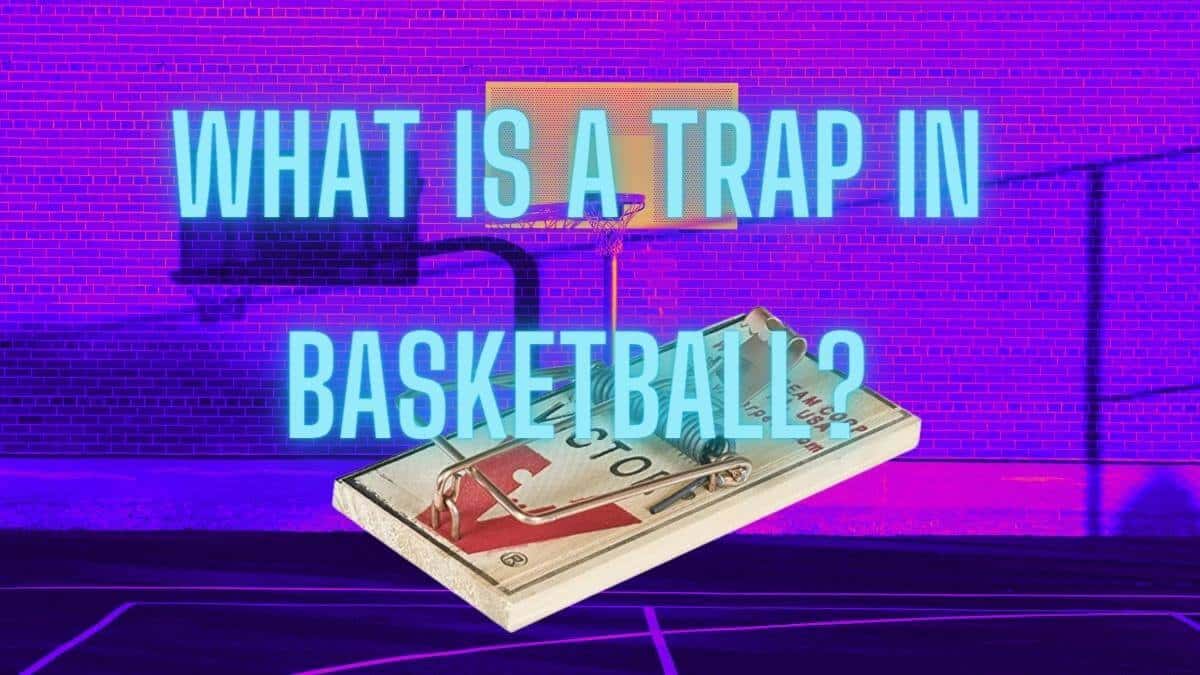A trap in basketball is a defensive maneuver designed to pin the opposing ball handler against the sideline with a double-team. The ultimate goal of a trap is to force a turnover, but it can serve to disrupt an offense and turn the tides of a game.
But that’s not the whole story. Basketball is an intricate game. Any strategy you deploy will carry a lot of subtle repercussions to consider.
In this post we’ll dive deep into the various types of traps, and the details of trapping as a strategy in basketball. we’ll cover the benefits and faults of executing a trapping defense, how and when to do it, and we’ll show you how to think through a trap in basketball games from first principles.
Let’s get to it…
The Mechanics of a Trap in Basketball
A trap can be executed any time. There are strategies that maximize trapping potential, but you don’t need to be pushing for a trap to find one. It does require a little timing and coordination.
First you need to be aware of the floor. Let’s take a look at some common trapping zones.

Notice how those zones run up along the natural boundaries of the court. This is important. While you can theoretically just surround the ball handler with players until they give up, that’s not a worthy strategy. You need to use the natural barriers of the court as an added defense.
Now, you can also trap along the baseline and in the corners. Those spots on the map are just a very common target for a trap in basketball games. Trapping under the basket is a little riskier so you might not want to get there unless you have to or you luck into it.
Your team needs to understand where a trap can occur, but they also should have an idea of where specifically they would like to place it. This strategy requires some coordination between defenders, so getting them on the same page can make a world of difference.
The on-ball defender is tasked with guiding the ball handler into the trapping zone. A nearby off-ball defender should be hanging around, trying not to look too shifty, clearing out the area. You apply pressure, but you want that ball handler to have a false sense of confidence. When the ball handler hits that zone, the second defender closes out.
So now you’ve got the ball locked down between 2 defenders and probably the sideline. They might be able to get out, but it’s going to take some work, some skill, and some time, and they might just give up the ball.
Types of Traps in Basketball
Trapping strategies in basketball are classified mostly based on the region of the court in which the trap is intended to occur. Let’s go over some of the most common types.
A Full-Court Trap in basketball is designed to attack across the entire court. This typically means setting up a backcourt trap which can be a little risky, but offers the opportunity to force a turnover deep in enemy territory.
A Half-Court Trap pushes to trap the ball at the half-court corners. This will typically mean stopping the ball handler on the sidelines between half-court and the free throw line. Closer to half-court is generally a better option because your opponent will be left with no backwards route without crossing that half-court line and triggering a penalty.
A Zone Trap seeks to trap near the wing sidelines and into the corners, deeper than the half-court trap. This style of trap can help disrupt jump shots and slow down scoring closer to the basket. This is typically a less risky action which pursues the trap less aggressively while maintaining alternate defensive strengths.
When a ball handler begins to beat their primary defender down the baseline from a corner, the low post may be able to jump in and lock them down while the defender has a moment to catch up. This can result in a Baseline Trap.
A Ball Screen Trap in basketball can occur in response to an offense laying down an on-ball screen. The screener’s defender executes a hard hedge, jumping out to cut off the ball handler and push them towards the sideline. The ball handler’s defender can then fight through the screen and move in from behind. This is an element of the ice defense.
Examples of Trapping Plays
The 1-1-2-1 Press
The Diamond Press
When to use a Trap in Basketball
You’ll take a trap whenever you can get it. But you’ll want to shift to a trapping-focused defense when you need a leg up. If you’re grinding away at the offense and you just keep giving up buckets, this is a great hail mary. Turn to it when you need turnovers and a shift in momentum.
If you’re able to contain the opponents point guard, that’s a big signal to start dipping into your bag of traps. Maybe they send someone in off the bench, or maybe you just find a matchup that’s effective, either way, if the offensive initiator is struggling, you will be more likely to force them into a pressured situation.
Benefits of a Trapping Defense in Basketball
An effective trap in basketball games can throw your opponent off their rhythm. A trapping defense will often be a press defense as well, which further strains an offense, pushing them to adapt.
When a team starts scoring, things can get out of hand quickly. One of the best applications of a trap is to shift the rhythm in this type of situation. Generate some turnovers and your opponent will be forced to make adjustments.
Even if you don’t force a turnover, you are probably slowing down your opponent as they negotiate this defensive pressure. A successful backcourt trap can make it difficult for your opponent just to make it into your territory. They’ll start to come up against 8-second violations and the shot clock, further pressuring a rushed decision.
Drawbacks of a Trapping Defense in Basketball
A trap is a double-team by it’s nature, so it can leave options on the floor. An effective ball handler can break your traps efficiently and take advantage of this.
There’s a baseline of athleticism that you should expect from your team before working trapping systems into your playbook with any regularity. It takes energy to set a trap. It takes energy to lock it down. And it takes energy to recover from a broken trap.
Even with an athletic team, pushing a trapping defense in a sustained way is exhausting. A lot of the most effective trapping plays are full court presses, so you’re pushing your squad to run all over the court and give persistent and aggressive on-ball coverage. This is going to gas them out
A well-versed coach should be able to spot and dismantle your traps easily. It’s not exactly subtle when you see a couple of defenders maneuvering your ball handler into a weak spot. And there are enough useful strategies to counter trapping defenses that you can expect them to shift that direction quickly.
How to Beat a Trap in Basketball
Ideally, you wouldn’t let yourself get here in the first place, at least not without seeing it coming. Start by running through some of the more common trapping defenses to make sure you understand the approach. Dig into these plays with your point guard if you’re working on a squad. One of your first lines of defense should be your point guard recognizing a trap before it’s set.
If you know you’re going up against a trapping defense, you should work on your escape skills. Even if you’re running the right offensive maneuvers and spotting guards out front as they look to block your path, you are still going to get caught up on occasion. Being ready with an escape plan is worth some time.
As far as planning for an independent escape, try running some drills where you push a ball handler up into two guards and let them work their way out. The handler should get low and protect the ball on their hip. Even in a solid trap, a hard dribble backwards followed by a drive into a defenders shoulder can get you through.
If you have a dribble left, you can take that low hip position and kick around a defender’s outside foot along the sideline. If you can get your foot forward quick enough, you can find the leverage needed to pull right through your defenders.
If your defenders have neglected to connect their knees closely enough, you can run a similar attach into the gap and ‘split’ the trap. As long as you stay low and find your balance, you should be able to push on through. Just keep your elbows in and watch out for catching a foul.
With two defenders tied up on the ball, you should also look at running an off-ball screen to get someone open enough that they can get hit on a pass. A tight trap will make a pass risky, but not impossible, especially if you’ve got a wide open target.
As trapping becomes a more pressing problem to your offense, turn to press break offenses. There are a wide array of plays designed to avoid and setup escapes from traps.
And a last ditch effort, the override switch to get out of a trap in basketball games is a timeout. If you’re managing all of the other possibilities and you’ve managed to mostly avoid getting stuck, you can always go to a timeout. It’s not ideal, but it can serve as a get out of traps free card.
Conclusion
Hopefully we’ve left you with a basic awareness of the strengths and weaknesses of a trapping defense in basketball. Trapping strategies will always have a place in a well-developed game plan, but they do require special considerations to be used effectively.
This can be an exciting technique to practice and discuss with a young team. You’ll likely want to have some trapping plays well established though before deploying this strategy in a game. While executing a successful trap can shift momentum dramatically in a game, there’s plenty of potential for disaster here if your team is unprepared or your opponent sees this coming.
Give it a shot and see how your team responds. Pick a trapping strategy and go over it until it flows. Work the movements out in a scrimmage. If you see the opportunity, break the strategy out in a pinch. But let me know if this helped at all.
